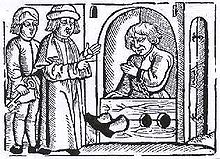
Serfdom in Poland was a legal and economic system that bound the peasant population to hereditary plots of land owned by the szlachta, or Polish nobility.[1] Emerging from the 12th century, this system became firmly established by the 16th century, significantly shaping the social, economic, and political landscape of the Polish–Lithuanian Commonwealth.[2]
Under this system, peasants were obligated to provide extensive labor services (corvée), while their personal freedoms were severely restricted.[3] The nobility's rights expanded over time through legal acts such as the Statutes of Piotrków in 1496, which limited peasants' mobility, and the Constitution Nihil novi in 1505, which enhanced noble privileges. These developments entrenched serfdom and created a rigid social hierarchy. [2]
Serfdom became central to the economy of the Polish–Lithuanian Commonwealth, underpinning its status as one of Europe’s leading agricultural producers. The Commonwealth relied heavily on the export of grain and other agricultural commodities to Western Europe. Through dependence on serf labor, the nobility accumulated wealth and sustained political influence, thereby reinforcing a rigid social order where the szlachta held significant power over the disenfranchised peasant class.[4]
Attempts to reform or abolish serfdom emerged during the late 18th and 19th centuries amid both internal and European political upheaval. The Constitution of 3 May 1791 aimed to improve conditions for peasants by placing them under state protection, yet it did not abolish serfdom.[5] The Połaniec Manifesto of 1794, issued during the Kościuszko Uprising, granted peasants limited rights, such as personal freedom and reduced labor obligations. Despite these efforts, the reforms were short-lived due to the uprising’s failure.[6]
Serfdom in Polish territories was ultimately abolished in the 19th century under foreign rule following the Partitions of Poland. In Prussian-controlled areas, serfdom was abolished through the Stein–Hardenberg reforms between 1807 and 1816. In Austrian Galicia, it was abolished in 1848 amid the Revolutions of 1848.[7] In the Russian-controlled Congress Poland, serfdom was finally abolished in 1864 following the January Uprising.[8] The abolition of serfdom led to significant social and economic transformations, facilitating modernization and contributing to the eventual restoration of Polish independence in 1918.
- ^ Cite error: The named reference
Davies1982was invoked but never defined (see the help page). - ^ a b Łukowski, Jerzy; Zawadzki, Hubert. A Concise History of Poland. Cambridge University Press, 2006.
- ^ Lukowski, Jerzy. The European Nobility in the Eighteenth Century. Palgrave Macmillan, 2003.
- ^ Frost, Robert I. The Oxford History of Poland-Lithuania, Volume I: The Making of the Polish-Lithuanian Union, 1385–1569. Oxford University Press, 2015.
- ^ Davies, Norman. God's Playground: A History of Poland, Vol. 2: 1795 to the Present. Oxford University Press, 1982.
- ^ Palmer, R. R. The Age of the Democratic Revolution: A Political History of Europe and America, 1760-1800 - Updated Edition. Princeton University Press, 2014.
- ^ Sheehan, James J. German History 1770–1866. Clarendon Press, 1989.
- ^ Kieniewicz, Stefan. Emancipation of the Polish Peasantry. University of Chicago Press, 2016.